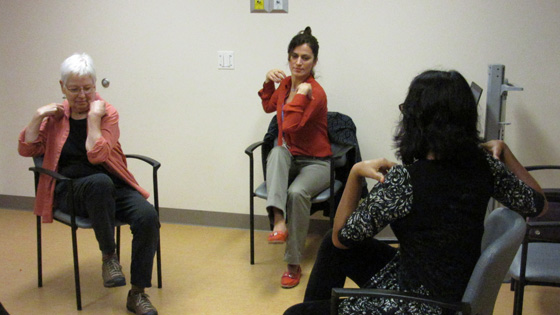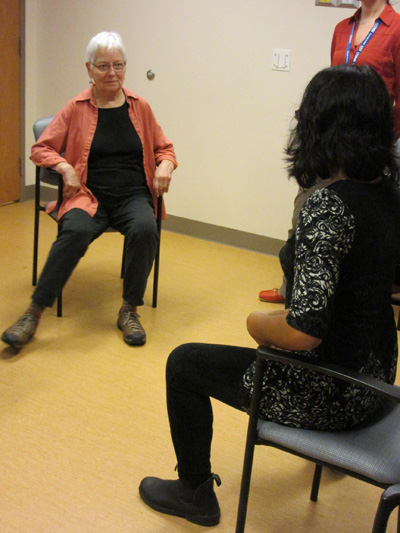
Pleasance, 77, (far left) participates in a Falls Prevention group every week at Toronto Rehab to work on strength and balance through exercise. (Photo: UHN)
For Pleasance, 77, walking is a source of independence, a form of physical activity, and an opportunity to stay connected with nature.
But, in recent years, it has also become a great health risk.
Over the past 15 years, Pleasance has suffered six falls – most of them outdoors, while walking. Each of Pleasance's falls has resulted in an emergency department visit.
She's not alone – between 20 and 30 per cent of older Canadians experience at least one fall every year, adding up to $2-billion a year in health-care costs.
"These falls, they could happen to anyone," Pleasance explains.
Related to this story:
A preventable risk
"Falls are an underappreciated, preventable health risk," explains Dr. Tilak Dutta, scientist at Toronto Rehabilitation Institute. Tilak works with the Home and Community team and focuses on falls prevention research.
"Falls prevention is so far-reaching. We will all either become at risk of falling at some point in our lives, or care for someone who is at risk."
At Toronto Rehab, Tilak is working with a team of researchers to examine how falls can be prevented in people's homes, and out in the community while also encouraging safe activity.
The Challenging Environment Assessment Lab (CEAL), found in the basement of Toronto Rehab, allows Dr. Dutta and his team to recreate day-to-day environmental challenges faced by older adults and those with disabling injury or illness. The researchers can test how to intervene and find ways to keep people active while preventing falls using a series of simulators.
Stairs, for example, present a significant falls risk.
Recently, Pleasance lost her footing on the stairs of her condominium building and fell forward. She caught herself, but broke a finger on the handrail while gripping onto it.
According to a report done by the Public Health Agency of Canada, using stairs is the third leading activity associated with falls.
"Considering how dangerous they are, it's almost crazy that we've gone this long without making them safer," Dr. Dutta says.

Toronto Rehab's CEAL, including labs such as StairLab, allows researchers to recreate day-to-day challenges in a controlled environment and find solutions to preventable falls. (Photo: UHN)
Research by his colleague, Alison Novak, in CEAL's StairLab has helped lead to a change in the National Building Code of Canada that will come into effect later this year.
There are three to four times more falls on stairs that are eight inches deep compared to those that are at a depth of 11 inches, suggests research from the UK. The building code will soon require stairs in Canada to have a minimum depth of 10 inches.
This small change is predicted to save over 100,000 injuries and 300 deaths by 2040.
"We are going to have a tremendous impact, but it's going to be hard to see because it will be the falls that don't happen at all," says Dr. Geoff Fernie, Director, Research, Toronto Rehab.
"To see what we've done," he explains, "we're going to have to do a good job of counting the hips that aren't broken, the parents who don't have to move in with their children, and the visits to the hospital that don't happen because someone didn't fall on bad stairs or slip on ice."
Walking safely
Pleasance remembers the first time she fell.
"It was, of course, painful and, all so new to me. I had never worn a cast before," she says.
The retired landscape history researcher takes walks with her husband, walks to complete her errands downtown, and even leads walks for the Toronto Field Naturalists.
Toronto Rehab research teams are now looking at improving sidewalks and streets to mitigate risks for people like Pleasance, who walk every day and need to do so safely.
An upcoming study will examine edges in the sidewalk and the most dangerous heights of sidewalk bumps when it comes to falls.

Dr. Tilak Dutta is a scientist at Toronto Rehab, researching how to prevent falls for seniors while keeping them active. (Photo: UHN)
"We have a hypothesis that people end up tripping on sidewalks not necessarily because of the biggest bumps– because people can see those – we actually think the smaller ones could be the problem," Dr. Dutta says.
"We think, the smaller the bump, the harder it is to see, the more likely it is that you'll trip over it."
The fear to fall
That study will begin in a few months. In the meantime, Pleasance has enrolled in a
Falls Prevention Group at Toronto Rehab.
Every week, she joins a group of seniors who are at risk of falls, with a physiotherapist and nurse who take them through a session. An hour lecture on topics such as risks for falls, healthy diets, or community resources is followed by an hour of exercise.
"The exercise program really focuses on improving strength, balance and flexibility," says Ramona Gheorghe, RN at the Falls Prevention & Geriatric Outpatient Clinic, who works with Pleasance and her falls prevention group.

The Falls Prevention program has allowed Pleasance and many other seniors to develop strength, balance and coordination. (Photo: UHN)
The 12-week program has allowed many participants to grow their skills, Ramona says.
"At the end, they are more confident, happier, and they've been able to make some new connections with people their age. They feel more assured in their ability and their strength."
Pleasance's goal has been to learn something new every week – and she says she has. There are exercises "that subtly help us with balance, coordination and strength, and I can do them at home," she says.
Pleasance's key takeaway has been to turn the fear of falling into a positive outlook.
"Often the fear of falling leads to people becoming sedentary and can lead to a downward spiral in health," Dr. Dutta explains. "The consequences of inactivity are just as severe as a fall."
Pleasance agrees and hopes to stay active by walking as long as she can.
"I acknowledge that once you've fallen there's a fear it'll happen again. But now I've learned to remind myself to look ahead while walking and anticipate risks," she explains.
November is Falls Prevention Month. Please visit the Toronto Rehab Home and Community team's website here to find out more about falls prevention.
